Part1 论文阅读与视频学习
1 MobileNet V1&V2
1.1 网络结构
传统卷积神经网络内存需求大,运算量大,导致无法在移动设备以及嵌入式设备上运行。MobileNet是专注于移动端和嵌入式设备的轻量级CNN网络,相比传统的卷积神经网络,它在准确率小幅度降低的同时大大减少了模型参数与运算量,MobileNet V1相比VGG准确率下降了0.9%,参数只有VGG的1/32。
MobileNetV1网络结构如下:

V1网络亮点:
- Depthwise Convolution(又叫DW卷积,大大减少运算量和参数量)
传统卷积的卷积核channel=输入特征矩阵channel,输出特征矩阵channel=卷积核个数,而DW卷积的卷积核channel为1,输入特征矩阵channel=卷积核个数=输出特征矩阵channel。
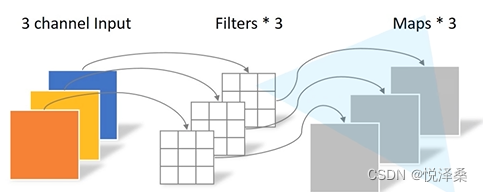
深度可分卷积(Depthwise Separable Convolution)=DW卷积+PW卷积(Pointwise Conv)
PW卷积是卷积核大小为1的普通卷积,理论上讲,普通卷积的计算量是CW+PW的8到9倍(此处默认输入矩阵和输出矩阵大小相同)
- 增加了两个人为设定的超参数α,β,α是Width Multiplier,用于控制卷积核个数,β是Resolution Multiplier,用于控制输入图像的大小
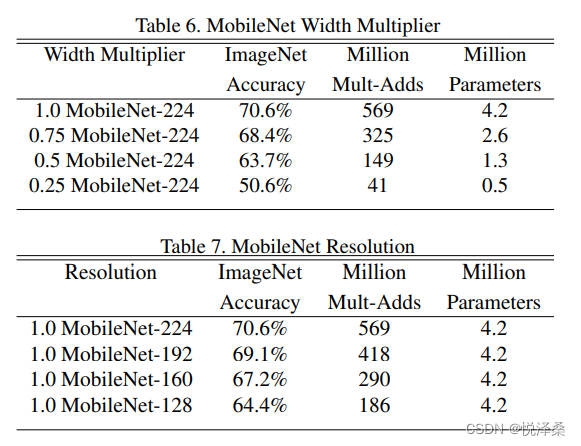
由此可见,可以通过适当的减小输入图像的大小,在准确率变化很小的情况下达到很少的参数量。但在实际使用中,DW卷积在大部分情况下没有起到作用,为解决这个问题,提出了MobileNetV2。V2准确率更高,模型更小。
V2网络亮点:
- Inverted Residuals(倒残差结构)
残差结构是先降维再升维,中间用3*3卷积,激活函数为ReLU:而倒残差结构是先升维再降维,中间用DW卷积,激活函数为ReLU6。ReLU6(x)=min(max(x,0),6),这使得激活函数的值不会超过6,更适合移动端设备,避免数值溢出带来的精度损失。倒残差结构如图,当stride=1且输入特征矩阵与输出特征矩阵的shape相同时才有shortcut连接。


- Linear Bottlenecks
V2的倒残差结构的最后一层1*1卷积用的是线性的激活函数,因为ReLU会对低维特征信息造成大量损失。
V2网络结构和参数如图,其中t是拓展音字,c是输出特征矩阵深度的channel,n是bottleneck的重复次数,s是第一层的步长,其他层的步长都是1:
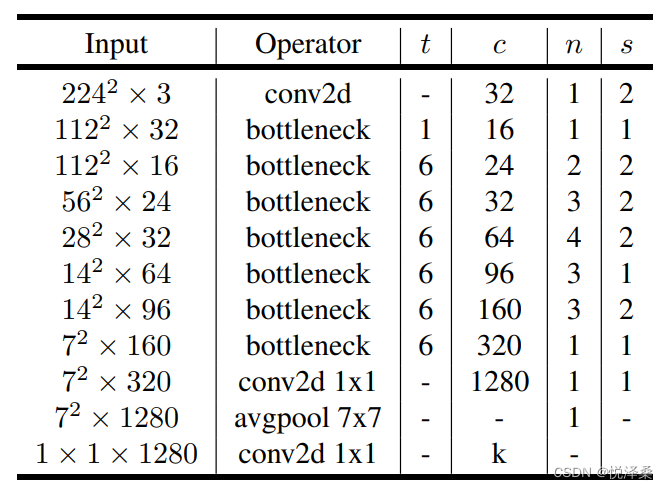
1.2 基于PyTorch搭建MobileNet V2
代码链接:(colab)MobileNet
import torch
from torch import nn
# V2
def _make_divisible(ch,divisor=8,min_ch=None):
if min_ch is None:
min_ch = divisor
new_ch = max(min_ch,int(ch*divisor/2)//divisor*divisor)
# 确保向下取整时不会超过10%
if new_ch<0.9*ch:
new_ch+=diviser
return new_ch
class ConvBNReLU(nn.Sequential):
# group为1是普通卷积,group为输入特征矩阵的深度(in_channel)是DW卷积
def __init__(self,in_channel,out_channel,kernel_size=3,stride=1,groups=1):
padding = (kernel_size-1)//2
super(ConvBNReLU,self).__init__(
nn.Conv2d(in_channel,out_channel,kernel_size,stride,padding,groups=groups,bias=False),
nn.BatchNorm2d(out_channel),
nn.ReLU6(inplace=True)
)
# 倒残差结构
class InvertedResidual(nn.Module):
# expand_ratio即拓展因子t
def __init__(self,in_channel,out_channel,stride,expand_ratio):
super(InvertedResidual,self).__init__()
# 隐层
hidden_channel = in_channel*expand_ratio
# 是否用shortcut
self.use_shortcut = stride==1 and in_channel==out_channel
layers = []
if expand_ratio!=1:
# 1*1 PW
layers.append(ConvBNReLU(in_channel,hidden_channel,kernel_size=1))
layers.extend([
# 3*3 DW
ConvBNReLU(hidden_channel,hidden_channel,stride=stride,groups=hidden_channel),
# 1*1 PW(Linear)
nn.Conv2d(hidden_channel,out_channel,kernel_size=1,bias=False),
nn.BatchNorm2d(out_channel)
])
self.conv = nn.Sequential(*layers)
def forward(self,x):
if self.use_shortcut:
return x+self.conv(x)
else:
return self.conv(x)
class MobileNetV2(nn.Module):
def __init__(self,num_classes=1000,alpha=1.0,round_nearest=8):
super(MobileNetV2,self).__init__()
block = InsertedResidual
input_channel = _make_divisible(32*alpha,round_nearest)
last_channel = _make_divisible(1280*alpha,round_nearest)
inverted_residual_setting=[
# t,c,n,s
[1,16,1,1],
[6,24,2,2],
[6,32,3,2],
[6,64,4,2],
[6,96,3,1],
[6,160,3,2],
[6,320,1,1],
]
features = []
# conv1 layer
features.append(ConvBNReLU(3,input_channel,stride=2))
for t,c,n,s in inverted_residual_setting:
output_channel = _make_divisible(c*alpha,round_nearest)
for i in range(n):
stride = s if i==0 else 1
features.append(block(input_channel,output_channel,stride,expand_ratio=t))
input_channel = output_channel
features.append(ConvBNReLU(input_channel,last_channel,1))
self.features = nn.Sequential(*features)
# 分类器
self.avgpool = nn.AdaptiveAvgPool2d((1,1))
self.classifier = nn.Sequential(
nn.Dropout(0.2),
nn.Linear(last_channel,num_classes)
)
# 权重初始化
for m in self.modules():
if isinstance(m,nn.Conv2d):
nn.init.kaiming_normal_(m.weight,mode='fan out')
if m.bias is not None:
nn.init.ones_(m.weight)
nn.init.zeros_(m.bias)
elif isinstance(m,nn.BatchNorm2d):
nn.init.ones_(m.weight)
nn.init.zeros_(m.bias)
elif isinstance(m,nn.Linear):
nn.init.normal_(m.weight,0,0.1)
nn.init.zeros_(m.bias)
def forward(self,x):
x = self.features(x)
x = self.avgpool(x)
x = torch.flatten(x,1)
x = self.classifier(x)
return x2 MobileNet V3
2.1 网络结构
在ImageNet分类任务中,V3比V2准确率更高,更高效,推理速度更快
V3网络亮点:
- 更新block(bneck)
在倒残差结构的基础上作了改动,加入了SE模块,更新了激活函数,当stride=1且input_c=output_c才有shortcut连接。
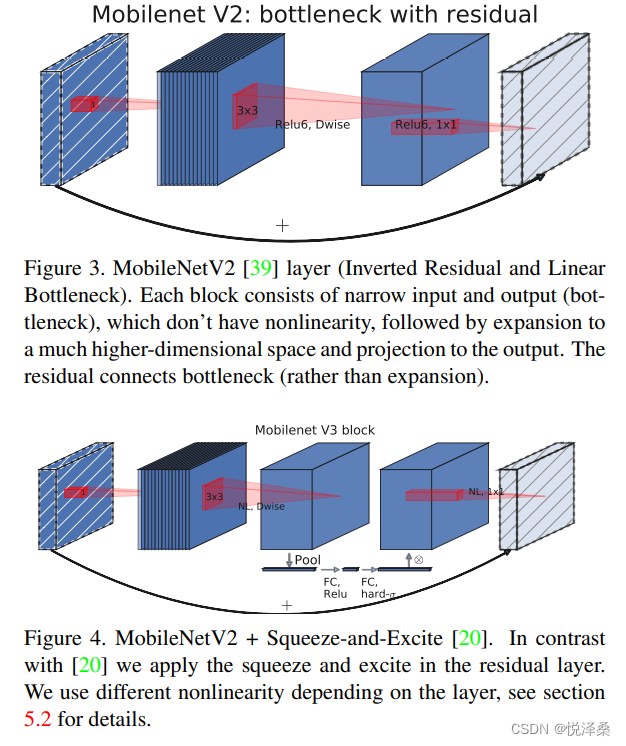
SE是通道注意力,对卷积得到的特征矩阵的每一个channel进行池化处理,再通过两个全连接层得到输出向量,第一个全连接层的结点个数为channel的四分之一,第二个全连接层的结点个数为channel
- 使用NAS搜索参数(Neural Architecture Search)
NAS是一种神经网络优化算法,先定义一组适用于我们网络的“构建块”再尝试以不同的方式组合这些“构建快”进行训练。通过这种试错方式,NAS算法最终能够确定哪一种“构建快”与哪一种网络配置可以得到最优结果。
卷积神经网络原理_怎样设计最优的卷积神经网络架构?| NAS原理剖析_LHZ5388015210的博客-CSDN博客
- 重新设计耗时层结构
减少了第一个卷积层的卷积核个数,由32个改为16个,并精简了Last Stage,减少了Last Stage的层数,保持了准确率,提升了速度。

- 重新设计了激活函数
目前常用的激活函数是swish(x)=x*σ(x),其中σ(x)是sigmoid函数,但它计算和求导较复杂,对量化过程不友好,因此V3使用的是h-swish(x)=x*ReLU6(x+3)/6,其中ReLU6(x+3)/6是h-sigmoid。

V3网络结构如下:
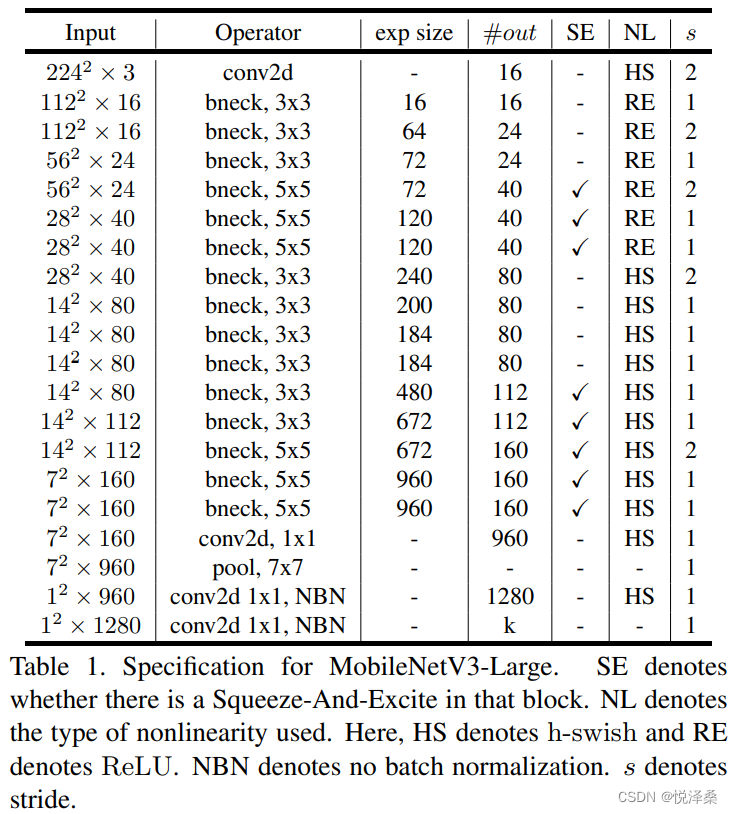
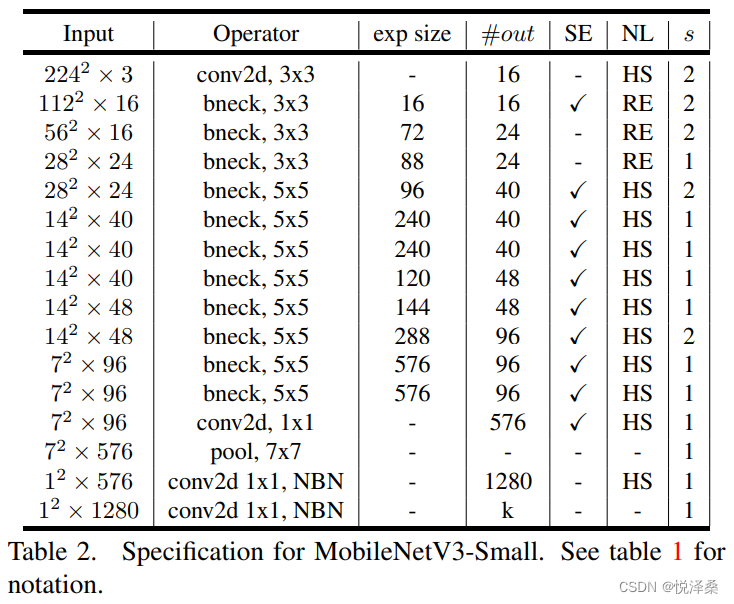
2.2 基于PyTorch搭建MobileNet V2
代码链接:(colab)MobileNet
import torch
from torch import nn,Tensor
from torch.nn import function as F
from typing import Callable,List,Optional
from functools import partial
# V3
def _make_divisible(ch,divisor=8,min_ch=None):
if min_ch is None:
min_ch = divisor
new_ch = max(min_ch,int(ch*divisor/2)//divisor*divisor)
# 确保向下取整时不会超过10%
if new_ch<0.9*ch:
new_ch+=diviser
return new_ch
class ConvBNActivation(nn.Sequential):
# group为1是普通卷积,group为输入特征矩阵的深度(in_channel)是DW卷积
def __init__(self,
in_planes:int,
out_planes:int,
kernel_size:int=3,
stride:int=1,
groups:int=1,
norm_layer:Optional[Callable[...,nn.Module]]=None,
activation_layer:Optional[Callable[...,nn.Module]]=None):
padding = (kernel_size-1)//2
if norm_layer is None:
norm_layer = nn.BatchNorm2d
if activation_layer is None:
activation_layer = nn.ReLU6
super(ConvBNActivation,self).__init__(nn.Conv2d(
in_channel=in_planes,
out_channel=out_planes,
kernel_size=kernel_size,
stride=stride,
padding=padding,
groups=groups,
bias=False),
norm_layer(out_planes),
activation_layer(inplace=True)))
# 注意力机制模块
class SqueezeExcitation(nn.Module):
def __init__(self,input_c:int,squeeze_factor:int=4):
super(SqueezeExcitation,self).__init__()
squeeze_c = _make_divisible(input_c//squeeze_factor,8)
self.fc1 = nn.Conv2d(input_c,squeeze_c,1)
self.fc2 = nn.Conv2d(squeeze_c,input_c,1)
def forward(self,x:Tensor) -> Tensor:
scale = F.adaptive_avg_pool2d(x,output_size=(1,1))
scale = self.fc1(scale)
scale = F.relu(scale,inplace=True)
scale = self.fc2(scale)
scale = F.hardsigmoid(scale,inplace=True)
return scale*x
# 倒残差结构
class InvertedResidualConfig:
def __init__(self,input_c:int,
kernel:int,
expanded_c:int,
out_c:int,
use_se:bool,
activation:str,
stride:int,
width_multi:float):
self.input_c = self.adjust_channels(input_c,width_multi)
self.kernel = kernel
self.expanded_c = self.adjust_channels(expanded_c,width_multi)
self.out_c = self.adjust_channels(out_c,width_multi)
self.use_se = use_se
self.use_hs = activation=="HS"
self.stride = stride
@staticmethod
def adjust_channels(channels:int,width_multi:float):
return _make_divisible(channels*width_multi,8)
# 倒残差结构
class InvertedResidual(nn.Module):
def __init__(self,cnf:InvertedResidualConfig,
norm_layer:Callable[...,nn.Module]):
super(InvertedResidual,self).__init__()
if cnf.stride not in [1,2]:
raise ValueError("illegal stride value.")
self.use_res_connect = (cnf.stride==1 and cnf.input_c==cnf.out_c)
layers:List[nn.Module] = []
activation_layer = nn.Hardswish if cnf.use_hs else nn.ReLU
if cnf.expanded_c != cnf.input_c:
layer.append(ConvBNActivation(cnf.input_c,
cnf.expanded_c,
kernel_size=1,
norm_layer=norm_layer,
activation_layer=activation_layer))
# DW卷积
layers.append(ConvBNActivation(cnf.expanded_c,
cnf.expanded_c,
kernel_size=cnf.kernel,
stride=cnf.stride,
groups=cnf.expanded_c,
norm_layer=norm_layer,
activation_layer=activation_layer))
if cnf.use_se:
layers.append(SqueezeExcitation(cnf.expanded_c))
layers.append(ConvBNActivation(cnf.expanded_c,
cnf.out_c,
kernel_size=1,
norm_layer=norm_layer,
activation_layer=nn.Identity))
self.block = nn.Sequential(*layers)
self.out_channels = cnf.out_c
def forward(self,x:Tensor) -> Tensor:
result = self.block(x)
if self.use_res_connect:
result += x
return result
class MobileNetV3(nn.Module):
def __init__(self,
inverted_residual_setting:List[InvertedResidualConfig],
last_channel:int,
num_classes:int=1000,
block:Optional[Callable[...,nn.Module]]=None,
norm_layer:Optional[Callable[...,nn.Module]]=None):
super(MobileNetV3,self).__init__()
if not inverted_residual_setting:
raise ValueError("The inverted_residual_setting should not be empty.")
elif not (isinstance(inverted_residual_setting,List) and
all([isinstance(s,InvertedResidualConfig) for s in inverted_residual_setting])):
raise TypeError("The inverted_residual_setting should be List[InvertedResidualConfig].")
if block is None:
block = InsertedResidual
if norm_layer is None:
norm_layer = partial(nn.BatchNorm2d,eps=0.001,momentum=0.01)
layers:List[nn.Module] = []
# 第一层
firstconv_output_c = inverted_residual_setting[0].input_c
layers.append(ConvBNActivation(3,firstconv_output_c,
kernel_size=3,
stride=2,
norm_layer=norm_layer,
activation_layer=nn.Hardswish))
# 倒残差模块
for cnf in inverted_residual_setting:
layers.append(block(cnf,norm_layer))
# 最后几层
lastconv_input_c = inverted_residual_setting[-1].out_c
lastconv_output_c = 6*lastconv_input_c
layers.append(ConvBNActivation(lastconv_input_c,
lastconv_output_c,
kernel_size=1,
norm_layer=norm_layer,
avtivation_layer=nn.Hardswish))
self.features = nn.Sequential(*layers)
# 分类器
self.avgpool = nn.AdaptiveAvgPool2d(1)
self.classifier = nn.Sequential(
nn.Linear(lastconv_output_c,last_channel),
nn.Hardswish(inplace=True)
nn.Dropout(p=0.2,inplace=True),
nn.Linear(last_channel,num_classes)
)
# 权重初始化
for m in self.modules():
if isinstance(m,nn.Conv2d):
nn.init.kaiming_normal_(m.weight,mode='fan out')
if m.bias is not None:
nn.init.zeros_(m.bias)
elif isinstance(m,(nn.BatchNorm2d,nn.GroupNorm)):
nn.init.ones_(m.weight)
nn.init.zeros_(m.bias)
elif isinstance(m,nn.Linear):
nn.init.normal_(m.weight,0,0.01)
nn.init.zeros_(m.bias)
def _forward_impl(self,x:Tensor) -> Tensor:
x = self.features(x)
x = self.avgpool(x)
x = torch.flatten(x,1)
x = self.classifier(x)
return x
def mobilenet_v3_large(num_classes:int=1000,reduced_tail:bool=False) -> MobileNetV3:
width_multi = 1.0
bneck_conf = partial(InvertedResidualConfig,width_multi=width_multi)
adjust_channels = partial(InvertedResidualConfig.adjust_channels,width_multi=width_multi)
reduce_divider = 2 if reduced_tail else 1
inverted_residual_setting = [
# input_c,kernel,expanded_c,out_c,use_se,activation,stride
bneck_conf(16,3,16,16,False,"RE",1),
bneck_conf(16,3,64,24,False,"RE",2), # C1
bneck_conf(24,3,72,24,False,"RE",1),
bneck_conf(24,5,72,40,True,"RE",2), # C2
bneck_conf(40,5,120,40,True,"RE",1),
bneck_conf(40,5,120,40,True,"RE",1),
bneck_conf(40,3,240,80,False,"HS",2), # C3
bneck_conf(80,3,200,80,False,"HS",1),
bneck_conf(80,3,184,80,False,"HS",1),
bneck_conf(80,3,184,80,False,"HS",1),
bneck_conf(80,3,480,112,True,"HS",1),
bneck_conf(112,3,672,112,True,"HS",1),
bneck_conf(112,5,672,160//reduce_divider,True,"HS",2), # C4
bneck_conf(160//reduce_divider,5,960//reduce_divider,160//reduce_divider,True,"HS",1),
bneck_conf(160//reduce_divider,5,960//reduce_divider,160//reduce_divider,True,"HS",1)]
last_channel = adjust_channels(1280//reduce_divider) # C5
return MobileNetV3(inverted_residual_setting=inverted_residual_setting,
last_channel=last_channel,
num_classes=num_classes)
def mobilenet_v3_small(num_classes:int=1000,reduced_tail:bool=False) -> MobileNetV3:
width_multi = 1.0
bneck_conf = partial(InvertedResidualConfig,width_multi=width_multi)
adjust_channels = partial(InvertedResidualConfig.adjust_channels,width_multi=width_multi)
reduce_divider = 2 if reduced_tail else 1
inverted_residual_setting = [
# input_c, kernel, expanded_c, out_c, use_se, activation, stride
bneck_conf(16,3,16,16,True,"RE",2), # C1
bneck_conf(16,3,72,24,False,"RE",2), # C2
bneck_conf(24,3,88,24,False,"RE",1),
bneck_conf(24,5,96,40,True,"HS",2), # C3
bneck_conf(40,5,240,40,True,"HS",1),
bneck_conf(40,5,240,40,True,"HS",1),
bneck_conf(40,5,120,48,True,"HS",1),
bneck_conf(48,5,144,48,True,"HS",1),
bneck_conf(48,5,288,96//reduce_divider,True,"HS",2), # C4
bneck_conf(96//reduce_divider,5,576//reduce_divider,96//reduce_divider,True,"HS",1),
bneck_conf(96//reduce_divider,5,576//reduce_divider,96//reduce_divider,True,"HS",1)]
last_channel = adjust_channels(1024//reduce_divider) # C5
return MobileNetV3(inverted_residual_setting=inverted_residual_setting,
last_channel=last_channel,
num_classes=num_classes)3 SENet
相关链接:SENet
3.1 网络基本原理
为提升神经网络的性能,SENet(Squeeze-and-Excitation Networks)考虑从特征通道之间的关系入手,显示地表现出特征通道之间的依赖关系。SENet采用了“特征重标定”策略,通过学习的方式自动获取每个特征通道的重要程度,再按照重要程度来抑制用处不大的特征,突出有用的特征。
SENet有两个关键操作,一个是Squeeze,另一个是Excitation,因此得名。SENet的重要结构是SE模块,SE模块示意图如图所示:
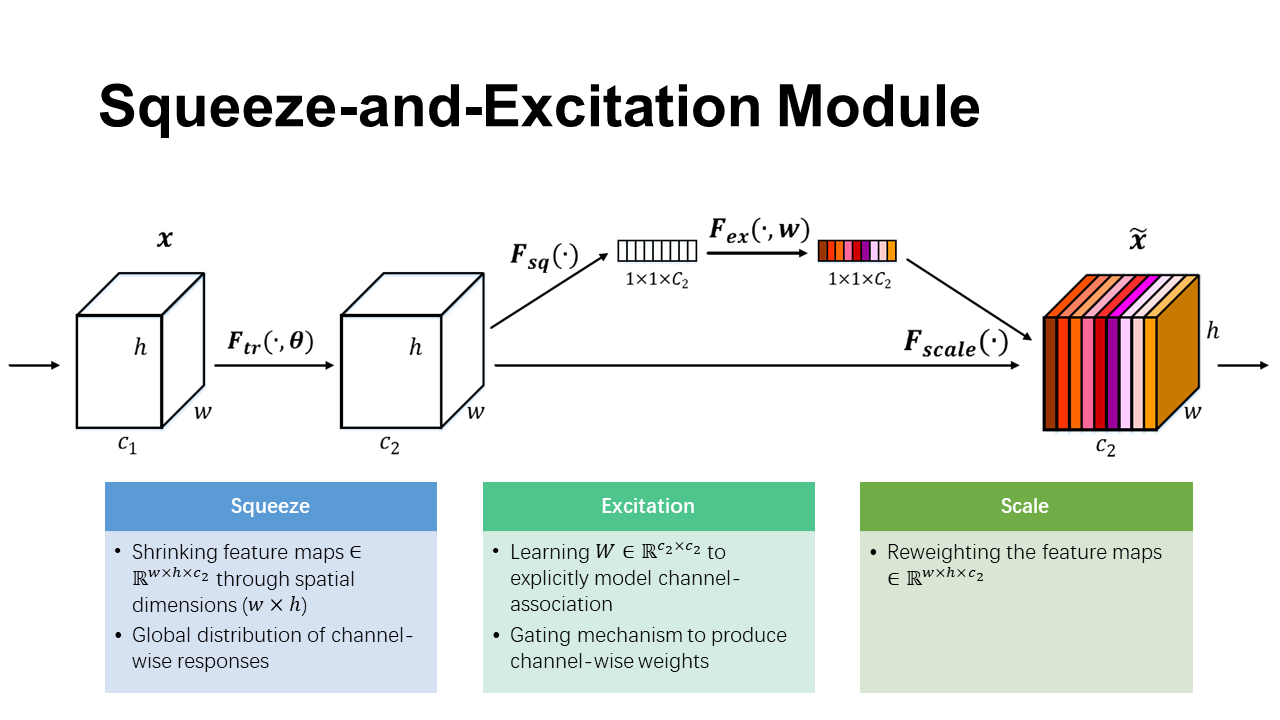
SE模块有三个操作:
- Squeeze操作:顺着空间维度进行特征压缩,将二维的特征通道转变为具有全局感受野的实数,并且要保证输出维度和输入特征通道数相匹配,使得靠近输入的层也能获得全局感受野。
- Excitation操作:类似于循环神经网络的门的机制,为每个特征通道生成权重,权重参数是通过学习得到的,能显示表现出特征通道间的相关性。
- Reweight操作:将得到的权重参数以乘法的形式加权到之前的特征上,实现在通道维度上的特征重标定。
SE模块具体结构如下,它可以嵌入到多种网络结构里发挥作用,容易部署,不需要引入新的函数或者层,有利于改善计算复杂度:
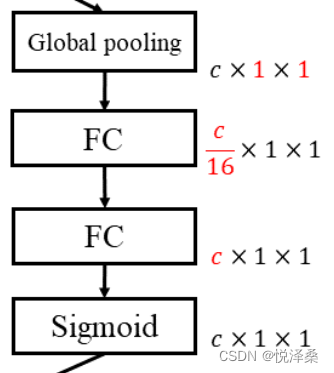
这里先使用全局平局池化作为Squeeze操作,再用两个FC组成Bottleneck结构进行Excitation。Excitation中先将特征维度降低到1/16,经过ReLU后再通过FC回到原来的维度,相比只用一个FC,这样处理有更多的非线性,并且能减少参数量。最后的Sigmoid使得最后能得到0~1的权重,再通过scale进行归一化,将权重加权到对应的特征上。
3.2 代码
import torch
import torch.nn as nn
import torch.nn.functional as F
import torchvision
import torchvision.transforms as transforms
import matplotlib.pyplot as plt
import numpy as np
import torch.optim as optim
class BasicBlock(nn.Module):
def __init__(self,in_channels,out_channels,stride=1):
super(BasicBlock,self).__init__()
self.conv1 = nn.Conv2d(in_channels,out_channels,kernel_size=3,stride=stride,padding=1,bias=False)
self.bn1 = nn.BatchNorm2d(out_channels)
self.conv2 = nn.Conv2d(out_channels,out_channels,kernel_size=3,stride=1,padding=1,bias=False)
self.bn2 = nn.BatchNorm2d(out_channels)
# shortcut的输出维度和输出不一致时,用1*1的卷积来匹配维度
self.shortcut = nn.Sequential()
if stride!=1 or in_channels!=out_channels:
self.shortcut = nn.Sequential(nn.Conv2d(in_channels,out_channels,kernel_size=1,stride=stride,bias=False),nn.BatchNorm2d(out_channels))
# excitation
self.fc1 = nn.Conv2d(out_channels,out_channels//16,kernel_size=1)
self.fc2 = nn.Conv2d(out_channels//16,out_channels,kernel_size=1)
#定义网络结构
def forward(self, x):
# 进行两次卷积得到压缩
out = F.relu(self.bn1(self.conv1(x)))
out = self.bn2(self.conv2(out))
# Squeeze
w = F.avg_pool2d(out,out.size(2))
# Excitation
w = F.relu(self.fc1(w))
w = F.sigmoid(self.fc2(w))
# 加权
out = out*w
# 加上浅层特征图
out += self.shortcut(x)
out = F.relu(out)
return out
class SENet(nn.Module):
def __init__(self):
super(SENet,self).__init__()
self.num_classes = 10
self.in_channels = 64
# 用64*3*3的卷积核
self.conv1 = nn.Conv2d(3,64,kernel_size=3,stride=1,padding=1,bias=False)
self.bn1 = nn.BatchNorm2d(64)
# BasicBlock
# 每个卷积层需要2个block块
self.layer1 = self._make_layer(BasicBlock,64,2,stride=1)
self.layer2 = self._make_layer(BasicBlock,128,2,stride=2)
self.layer3 = self._make_layer(BasicBlock,256,2,stride=2)
self.layer4 = self._make_layer(BasicBlock,512,2,stride=2)
self.linear = nn.Linear(512,self.num_classes)
#实现卷积
#blocks为大layer中的残差块数
#定义每一个layer有几个残差块,resnet18是2,2,2,2
def _make_layer(self,block,out_channels,blocks,stride):
strides = [stride]+[1]*(blocks-1)
layers = []
for stride in strides:
layers.append(block(self.in_channels,out_channels,stride))
self.in_channels = out_channels
return nn.Sequential(*layers)
def forward(self, x):
out = F.relu(self.bn1(self.conv1(x)))
out = self.layer1(out)
out = self.layer2(out)
out = self.layer3(out)
out = self.layer4(out)
out = F.avg_pool2d(out,4)
out = out.view(out.size(0),-1)
out = self.linear(out)
return outPart2 代码作业
2.1 2D卷积与3D卷积
高光谱图像是三维立体数据,包含两个空间维度和一个光谱维度。对高光谱图像来说,二维卷积可以提取空间特征,但不能提取光谱特征,三维卷积可以同时提取空间特征和光谱特征,有利于提升分类准确率,但计算比二维卷积复杂。因此,《HybridSN: Exploring 3D-2D CNN Feature Hierarchy for Hyperspectral Image Classification》这篇论文结合二维卷积和三维卷积的优势,先使用三维卷积,再使用二维卷积,最后连接分类器,既能发挥三位卷积的优势,充分提取特征,也避免了三维卷积的过多使用导致模型复杂。
2.2 HybridSN
HybridSN结构如下:

代码链接:(colab)HybirdSN
网络部分代码补充:
class_num = 16
class HybridSN(nn.Module):
def __init__(self,num_classes=16):
super(HybridSN,self).__init__()
self.conv1 = nn.Conv3d(1,8,(7,3,3))
self.bn1=nn.BatchNorm3d(8)
self.conv2 = nn.Conv3d(8,16,(5,3,3))
self.bn2=nn.BatchNorm3d(16)
self.conv3 = nn.Conv3d(16,32,(3,3,3))
self.bn3=nn.BatchNorm3d(32)
self.conv4 = nn.Conv2d(576,64,(3,3))
self.bn4=nn.BatchNorm2d(64)
self.drop = nn.Dropout(p=0.4)
self.fc1 = nn.Linear(18496,256)
self.fc2 = nn.Linear(256,128)
self.fc3 = nn.Linear(128,num_classes)
self.relu = nn.ReLU()
# 论文里有加softmax,但本次实验下loss下降特别慢,因此没有使用
self.softmax = nn.Softmax(dim=1)
def forward(self,x):
out = self.relu(self.bn1(self.conv1(x)))
out = self.relu(self.bn2(self.conv2(out)))
out = self.relu(self.bn3(self.conv3(out)))
out = out.view(-1,out.shape[1]*out.shape[2],out.shape[3],out.shape[4])
out = self.relu(self.bn4(self.conv4(out)))
out = out.view(out.size(0),-1)
out = self.fc1(out)
out = self.drop(out)
out = self.relu(out)
out = self.fc2(out)
out = self.drop(out)
out = self.relu(out)
out = self.fc3(out)
# out = self.softmax(out)
return out
# 随机输入,测试网络结构是否通
x = torch.randn(1,1,30,25,25)
net = HybridSN()
y = net(x)
print(y.shape)相关资源下载:
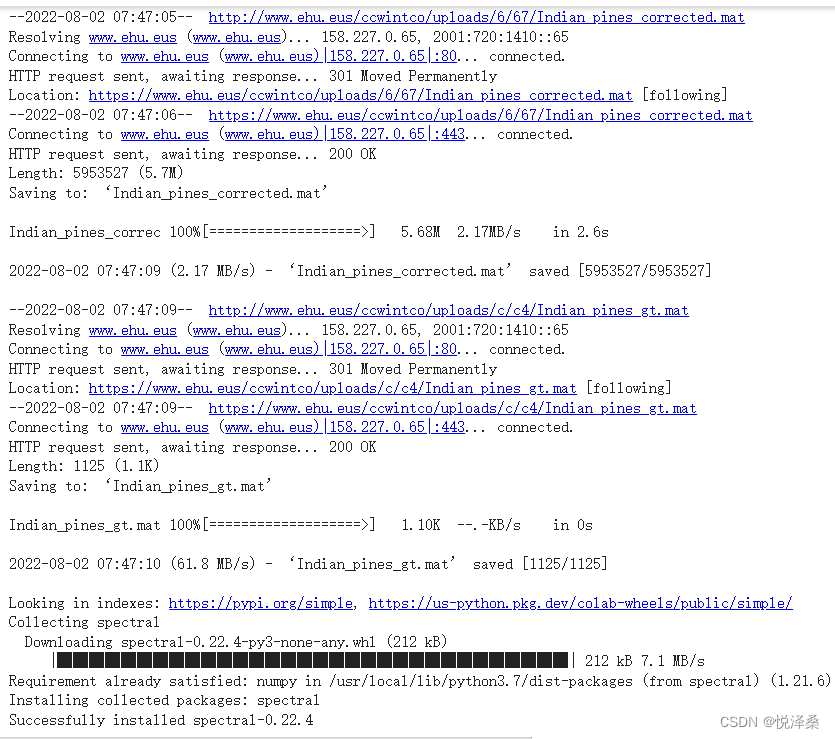
数据处理:

训练:
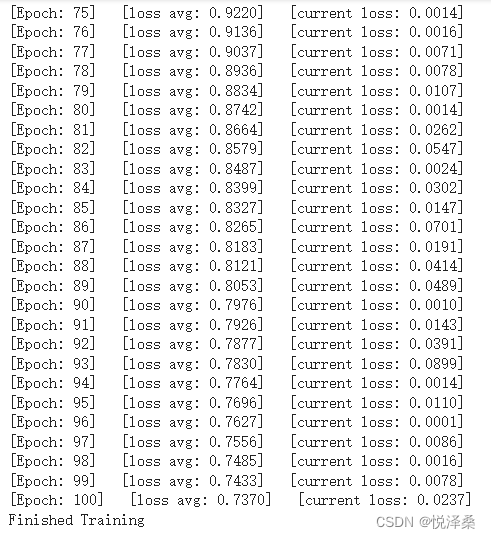
模型测试:

将分类结果写入文件:
第一次:
97.4536466477302 Kappa accuracy (%)
97.7669376693767 Overall accuracy (%)
94.13603236733026 Average accuracy (%)
precision recall f1-score support
Alfalfa 0.95 0.93 0.94 41
Corn-notill 1.00 0.93 0.96 1285
Corn-mintill 0.94 0.99 0.97 747
Corn 0.97 0.99 0.98 213
Grass-pasture 0.94 0.98 0.96 435
Grass-trees 0.98 1.00 0.99 657
Grass-pasture-mowed 0.92 0.96 0.94 25
Hay-windrowed 0.99 1.00 1.00 430
Oats 0.75 0.50 0.60 18
Soybean-notill 0.99 0.98 0.98 875
Soybean-mintill 0.97 0.99 0.98 2210
Soybean-clean 0.97 0.96 0.97 534
Wheat 0.99 0.96 0.98 185
Woods 1.00 0.99 1.00 1139
Buildings-Grass-Trees-Drives 0.98 0.97 0.98 347
Stone-Steel-Towers 0.88 0.93 0.90 84
accuracy 0.98 9225
macro avg 0.95 0.94 0.95 9225
weighted avg 0.98 0.98 0.98 9225
[[ 38 0 0 0 0 2 1 0 0 0 0 0 0 0
0 0]
[ 1 1200 23 1 5 0 0 0 1 7 43 1 0 1
1 1]
[ 0 0 740 0 3 0 0 0 0 0 0 3 1 0
0 0]
[ 0 0 3 210 0 0 0 0 0 0 0 0 0 0
0 0]
[ 0 0 2 0 428 1 0 0 0 0 4 0 0 0
0 0]
[ 0 0 0 0 0 655 0 0 1 0 1 0 0 0
0 0]
[ 0 0 0 0 1 0 24 0 0 0 0 0 0 0
0 0]
[ 0 0 0 0 0 0 0 429 0 1 0 0 0 0
0 0]
[ 0 0 8 0 0 1 0 0 9 0 0 0 0 0
0 0]
[ 1 0 0 0 9 3 0 0 0 856 3 2 1 0
0 0]
[ 0 2 6 0 1 4 0 1 0 1 2191 0 0 2
2 0]
[ 0 0 2 4 0 0 0 0 1 1 0 514 0 0
2 10]
[ 0 0 0 1 5 0 1 0 0 0 0 0 178 0
0 0]
[ 0 1 0 0 0 0 0 1 0 0 2 1 0 1133
1 0]
[ 0 0 0 0 1 0 0 1 0 0 8 1 0 0
336 0]
[ 0 0 0 0 0 0 0 0 0 0 0 6 0 0
0 78]]第二次:
97.53900729242903 Kappa accuracy (%)
97.84281842818429 Overall accuracy (%)
95.58275885289382 Average accuracy (%)
precision recall f1-score support
Alfalfa 0.95 0.88 0.91 41
Corn-notill 0.98 0.95 0.97 1285
Corn-mintill 0.97 0.99 0.98 747
Corn 0.96 0.99 0.97 213
Grass-pasture 1.00 0.96 0.98 435
Grass-trees 0.99 0.99 0.99 657
Grass-pasture-mowed 1.00 1.00 1.00 25
Hay-windrowed 0.99 1.00 0.99 430
Oats 0.82 0.78 0.80 18
Soybean-notill 0.98 0.98 0.98 875
Soybean-mintill 0.97 0.99 0.98 2210
Soybean-clean 0.97 0.97 0.97 534
Wheat 0.97 0.98 0.98 185
Woods 0.99 1.00 0.99 1139
Buildings-Grass-Trees-Drives 0.99 0.95 0.97 347
Stone-Steel-Towers 0.90 0.89 0.90 84
accuracy 0.98 9225
macro avg 0.96 0.96 0.96 9225
weighted avg 0.98 0.98 0.98 9225
[[ 36 0 0 1 0 0 0 3 0 0 1 0 0 0
0 0]
[ 2 1219 1 0 0 2 0 0 0 6 51 3 0 1
0 0]
[ 0 1 741 5 0 0 0 0 0 0 0 0 0 0
0 0]
[ 0 0 1 211 0 1 0 0 0 0 0 0 0 0
0 0]
[ 0 1 12 0 416 0 0 0 0 1 4 1 0 0
0 0]
[ 0 2 0 0 0 649 0 0 0 0 2 0 2 2
0 0]
[ 0 0 0 0 0 0 25 0 0 0 0 0 0 0
0 0]
[ 0 0 0 0 0 0 0 429 0 0 0 0 0 0
0 1]
[ 0 0 3 0 0 0 0 0 14 0 0 0 1 0
0 0]
[ 0 2 1 0 0 0 0 0 2 859 3 4 0 1
2 1]
[ 0 3 1 0 1 3 0 0 0 10 2186 0 0 6
0 0]
[ 0 0 3 3 0 0 0 1 1 0 0 519 0 0
1 6]
[ 0 2 0 0 1 0 0 1 0 0 0 0 181 0
0 0]
[ 0 4 0 0 0 0 0 0 0 0 0 0 0 1135
0 0]
[ 0 6 0 0 0 0 0 0 0 1 5 0 2 2
331 0]
[ 0 0 0 0 0 0 0 0 0 0 0 9 0 0
0 75]]可视化结果:

2.3 思考
① 测试了两次,发现这两次的结果不同,是因为网络中采用了dropout,每次使用该网络时丢弃的节点不相同,并且测试时没有将网络设置为eval。
② 进一步提升高光谱图像的分类性能,可以考虑加入SE注意力机制模块,或者引入Bottleneck结构调整特征的维度。